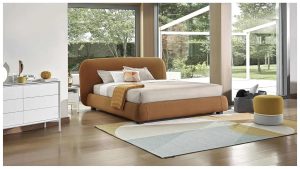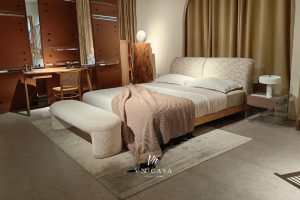Mastering the Art of Mixing Bedroom Furniture

Have you ever stepped into a bedroom that just feels perfect—warm, nice-looking, and full of charm? That comes from blending furniture in a smart way. People no longer buy whole sets that match exactly. Now, it’s about making a space that shows who you are. If you want to know how to mix and match bedroom furniture without creating a mess, this is the place. This guide takes you through the simple steps. It starts with choosing items that go well together. Then, it covers adding those last details that make everything shine. Let’s get started. Turn your bedroom into a spot you enjoy every day.
Why Mix and Match Your Bedroom Furniture?
Blending furniture is more than a fad. It brings layers and keeps the room lively. Picture this: a space with all the same pieces looks dull, like a store display. But combine various types, and it gains life. It shows your taste—perhaps a little new here, a bit old there.
The Benefits of a Mixed Approach
To start, it helps your wallet. You don’t need to swap out everything right away. Pick up a fresh bed frame. Keep your current dresser. Link them with good picks. Also, it allows you to try things out. Like to include that family nightstand? Sure. The main thing is evenness. When done properly, blended furniture makes your bedroom feel homey and welcoming.
Common Pitfalls to Avoid
You can easily overdo it. Too many colors or looks that clash, and the space seems wrong. Begin with small changes. Choose a main spot, like the bed. Build from there. Keep in mind, differences are fine. But togetherness matters more. We’ll talk about getting that next.
Understanding Furniture Categories
Furniture fits into a few key groups. Learning them aids in selecting items that fit nicely. These include wood shades, colored ones, metals, and soft-covered choices. Each adds its own feel to the area.
Wood and Natural Materials
Wood feels warm and lasting. Bright woods lighten up a room. Dark ones bring in some drama. Cane or rattan adds feel without taking over. Here’s the tip: Don’t try to match shades perfectly unless they come from the same group. Set them apart instead. For instance, team a bright wood bed with deeper side tables. That builds eye appeal.
Painted and Metal Pieces
Colored furniture adds hue. A gentle blue dresser can ease a plain room. Metals, such as on bed bases, provide glow and sharpness. Brass or iron fits well in fresh setups. Combine these with woods for steadiness—imagine a colored nightstand by a wooden headboard. Just make sure the hues don’t argue.
Upholstered Options
These are the comfy highlights: beds with cloth tops or soft seats. They bring gentleness. Go for plain fabrics to keep options open. Or pick strong patterns for impact. A linen-covered bed goes well with smooth metal bits. It stops the room from seeming too stiff or chilly.
Building a Cohesive Color Scheme
Hues connect it all. Without a plan, your blends might seem scattered. Begin with a set of colors that match your mood—quiet neutrals or bright spots.
Choosing Complementary Tones
Select a chief color from your walls or covers. Then add in highlights. Warm shades like tans and yellows feel snug. Cool ones like grays and blues stay calm. Use a board to try out thoughts. Stick photos of items you favor and check if they blend.
Examples of Winning Combinations
Check this quick chart for ideas:
|
Focal Piece |
Complementary Items |
Why It Works |
|
Cream upholstered bed |
Dark wood dresser, light painted nightstands |
Sets apart feels while holding warm hints |
|
Floral headboard |
Neutral side tables, cream accents |
Design sets the colors; plain ones even it out |
|
Dark cane bed |
Blue painted tables, striped chair |
Blends stuff with common old-time shapes |
These arrangements show how differences make smoothness. Give them a shot in your area.
Matching Styles Without Going Matchy-Matchy

Looks count as much as hues. A smooth new bed next to a fancy old dresser? Not great. But mix with care, and it works well.
Blending Traditional and Modern
Old-style items have bends and details. New ones stay straight and plain. Pair them by repeating forms. A bed with basic lines fits a dresser with light curves. Toss in a seat that links them—maybe middle-era with straight legs.
When Mixing Styles Works Best
It stands out in mixed rooms. A metal bed base with old-time feel teams with current wood tables if legs line up a bit. Stay away from wild differences. Super-new shiny next to rough pine seldom fits. Check by putting things close if possible.
Real-World Tips for Style Harmony
- Check legs: Like shapes bring unity.
- Even sizes: Don’t make a tiny bed look small with big tables.
- Include plains: They quiet down strong blends.
Mastering Wood Finishes
Woods can trick you. Mix badly, and they fight. But do it right, and your space gets warmth and richness.
Tone and Undertone Basics
Shade means bright or dark. Hint below is the base—warm (yellowish) or cool (gray-like). Mostly stay with one group. Warm woods seem friendly. Cool ones look sharp.
Rules for Mixing Woods
Go by these moves:
- Choose a main wood for large things like the bed or ground.
- Put in 1-2 highlights in opposite shades.
- Steady hints—mostly warm or cool.
- Place them around: No bunching one kind on a side.
For set-apart, try bright, middle, and dark. A bright bed, middle dresser, dark seat. It pulls the eye through.
Handling Mismatches
If woods clash, add a link item. A floor cover with both warm and cool parts aids. Or pictures that draw hues in. It’s about movement, not being perfect.
Tying It All Together with Decor
Furniture sets the base. But extras finish it off. Floor covers, window hangings, and bed stuff make blends whole.
The Role of Textiles
A ground rug holds the area. Pick one that repeats furniture hues. Window hangings add tallness and softness. Bed stuff layers in designs or plains.
Art and Accessories
Wall pictures fill empty spots. Mirrors spread light. Lights give use and look. Choose ones that nod to your furniture—brass lights with metal beds, say.
Before and After Transformations
Think of a basic room: matching wood group. Now blend: Change one table for colored, add a design rug. All at once, it’s lively. Fabrics change it.
Discover VN CASA Foshan Furniture: Your Go-To Supplier
When you want to find items for your blended bedroom, look to a trusty source like VN CASA Foshan Furniture. Set in the center of China’s furniture area, we link you straight to good factories for strong items at honest costs. With more than 160 partner factories and help to over 100 lands, we take care of all from picking to sending. Our group of experts aids in fitting looks to what you need. We cover many designs. If you set up one room or a full house, we keep it easy and pleasing. Look at our items, help, examples, and updates for thoughts.
Conclusion
Blending and matching bedroom furniture changes a plain area into something unique. By combining groups, hues, looks, and ends, you make a space that’s all yours. Keep in mind, it’s about steadiness and what seems good to you. With these ideas, you’re ready to create a bedroom that greets you each evening.
FAQs
How to mix and match bedroom furniture without making it look cluttered?
Hold a single color set and place opposite items evenly. Begin with a main point like the bed. Then add highlights that go with it. Use extras like rugs to link all nicely.
What are the best ways to mix wood tones when learning how to mix and match bedroom furniture?
Pick one chief shade and add set-aparts in bright, middle, or dark kinds. Stay with warm or cool hints for togetherness. Place them through the room to skip groups.
Can I mix different styles while figuring out how to mix and match bedroom furniture?
Sure, if you repeat parts like leg forms or metal bits. Blend old with new by using plain links. But skip big clashes for a whole feel.
How does decor help in how to mix and match bedroom furniture?
Fabrics and add-ons draw hues and feels in. A picked rug or window hangings can turn unmatched items into planned and neat.
Where can I find quality pieces for how to mix and match bedroom furniture?
Search for sources like VN CASA Foshan Furniture. They give varied looks straight from factories. They offer tips to fit your plan without trouble.






